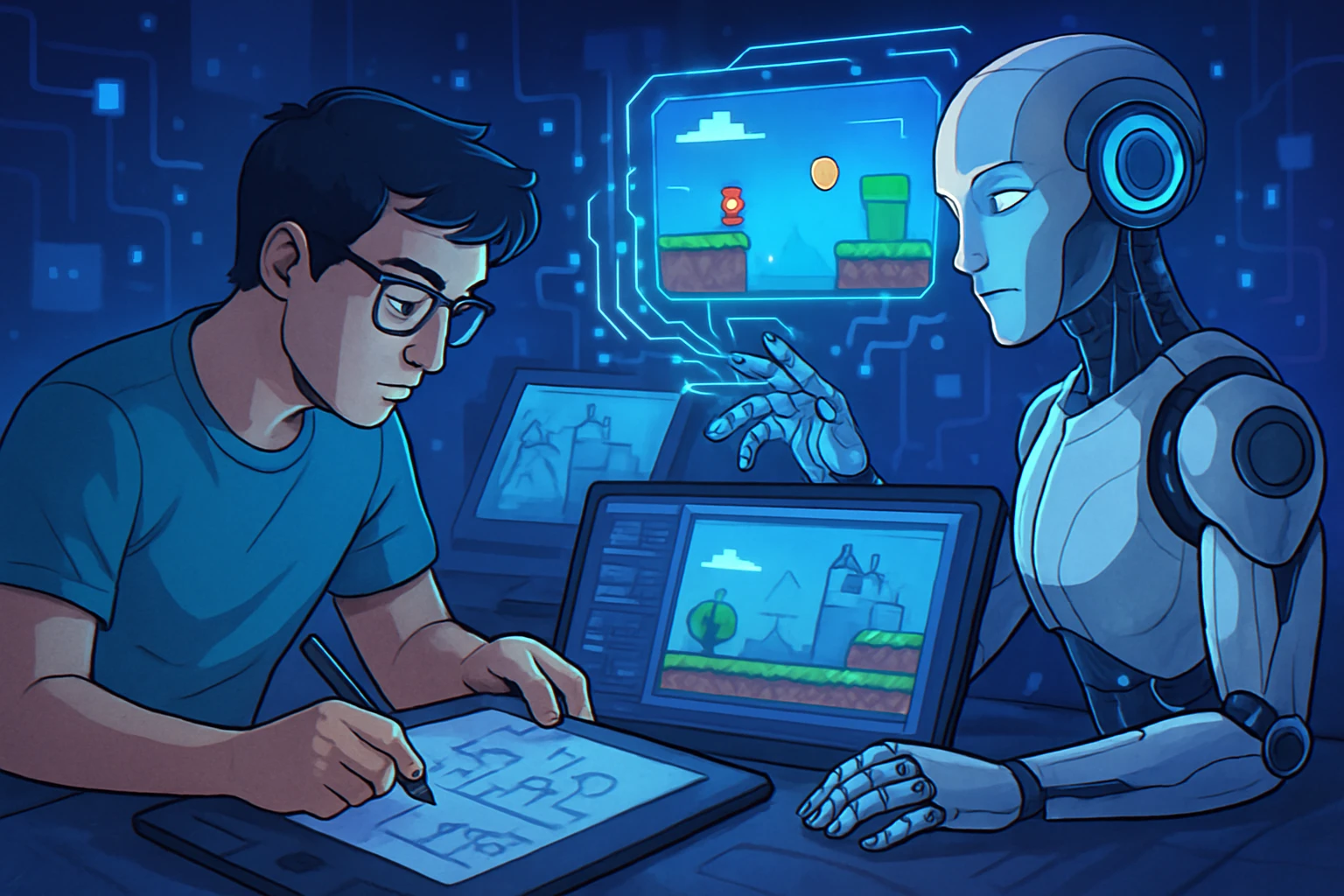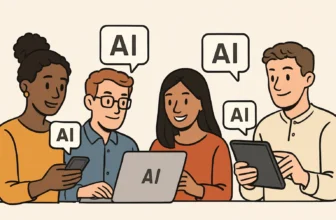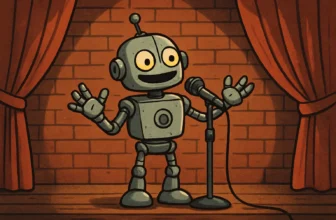
Why AI is the New Game Design Game-Changer
Did you know that over 70% of game studios are already integrating AI into their development pipelines? Crazy, right? It kind of blows my mind how fast it’s all happening. Not long ago, AI in games meant basic NPC pathfinding or a slightly smarter enemy bot. But now? We’re talking fully adaptive worlds, procedurally generated narratives, and characters that might actually learn from how you play. Wild.
So let’s pause for a second and really think about what that means. Imagine you’re building a game. In the past, you’d spend weeks—sometimes months—crafting every single quest, every line of dialogue, every enemy encounter. But what if AI could handle the busywork so you could focus on the big creative strokes? Even better, what if it could evolve your game world in real-time based on each player’s style, choices, and bizarre obsession with collecting 400 apples for no good reason?
We’re seeing a whole new era of AI in game design, and it’s not only upping the bar—it’s redefining the game altogether. And I don’t mean that lightly.
So what’s actually changing?
- Procedural generation with personality: AI techniques are letting devs generate fully fleshed-out game worlds that aren’t just random – they make sense thematically and even emotionally. (Think “No Man’s Sky” with real story depth.)
- Intelligent NPCs: These aren’t your typical “hello traveler” shopkeepers. We’re seeing characters who respond to tone, attitude, and even your play history. It’s like they’re… alive?
- Player-personalized gameplay: This one’s my favorite. AI is now smart enough to tweak gameplay difficulty, hint systems, and even quests based on how YOU play. I played a recent RPG that basically became a stealth-heavy game just because I kept crouching in bushes. Genius.
How can devs start tapping into this?
Alright, so if you’re a game dev—indie or AAA—here’s how to get in on this revolution:
- Explore AI-powered tools like Unity’s ML-Agents Toolkit or Microsoft’s Project Paidia. You don’t need to know machine learning inside-out to start experimenting.
- Use AI to speed up iteration. Want to test 12 versions of a level layout? Let generative AI create them for you. Then you just pick and polish. Boom—more time to work on killer boss fights.
- Start small with NPC behavior or dialogue trees. Tools like Inworld or Convai make it easier to build conversational agents. Even adding one smart character to your game can massively boost immersion.
Here’s the wild thing…
I remember watching a friend play a modded Skyrim where the NPCs seemed weirdly nuanced. It turns out someone had plugged in rudimentary AI that adjusted their personalities over time. I was hooked. That moment stuck with me because it was the first time I felt like the game world was living alongside me, not just reacting to me. And now, that’s going mainstream.
AI isn’t replacing human creativity—it’s supercharging it. Whether you’re a gamer discovering story twists that feel written just for you, or a developer ready to break creative boundaries, this is the moment we’ve been waiting for. The robots aren’t taking over—they’re collaborating. And honestly? I’m here for it.
Ready to see what happens when machine brains and human hearts design games together? Let’s dive in.
Bringing Games to Life with AI
Did you know that over 18 quintillion planets make up the universe in No Man’s Sky? Yep, quintillion—with a “Q”! And guess what? It’s all thanks to AI-powered procedural generation. Mind-blowing, right?
Let’s be real for a second. We’ve all played that game where every level starts to feel like déjà vu. Same terrain, same NPC behavior, maybe even the same enemies just wearing slightly different helmets. It’s like the game world is just… stuck on loop. As a gamer, it gets boring fast. As a developer, it can be frustrating to keep environments engaging without doubling your workload (or your team size).
I’ve personally felt the pain of that static vibe—roaming endlessly, hoping something new will pop up. But here’s where AI swoops in with a cape.
The AI-Powered Fix: Dynamic Worlds That Evolve
So what exactly is AI doing to shake things up? Enter procedural content generation (PCG), where algorithms create game content—like maps, missions, even weather—on the fly. Instead of hand-designing every cave, tree, and loot crate, developers can set a few intelligent rules, and then *poof*—whole worlds emerge almost as if by magic.
No Man’s Sky is the superstar example. It uses AI systems to generate entire galaxies where every planet is unique. Flora, fauna, terrain—all dynamically produced. And the kicker? Players are discovering places the developers themselves have never seen. Wild, right?
But it’s not just about big, open-world games. Rogue-likes like Spelunky use AI to build fresh dungeon layouts every time you die (which, let’s be honest, happens often), keeping gameplay unpredictable and fun.
Want to Add Some AI Magic to Your Game? Here’s How:
- Start small with rule-based systems – Define parameters like terrain types, enemy spawn behavior, or puzzle layout formats. Tools like Tiled or Unity’s built-in tilemaps are great for this.
- Use AI content generation tools – Dive into tools like Perlin noise for terrain or try open-source libraries like Procgen by OpenAI for level creation.
- Optimize player feedback loops – Use AI to adapt environments based on player choices. If someone keeps exploring caves, make those caves cooler and more frequent.
And here’s a quick win: if you’re already in Unity or Unreal, there are plenty of procedural generation plugins (like Dungeon Architect) that take a lot of the heavy lifting off your plate. Experiment, tweak, and let the algorithms do their thing.
The Bottom Line
AI is giving us a real shot at breaking the mold—transforming static sets into living, breathing game worlds that feel fresh every time you boot up. We’re not just designing environments anymore. We’re guiding ecosystems.
So if you’re a dev dreaming of building richer worlds without burning out, take a cue from the AI toolbox. Your future players (and your future self) will thank you.
Personalized Gaming Experiences with AI
Did you know that over 70% of gamers say they want more tailored in-game experiences—but less than 15% feel like they’re getting them? That’s wild, right?
It totally hits home for me. I remember playing a massive RPG where the quests felt, well… *paint-by-numbers*. Like the game was oblivious to my playstyle—charging headfirst into battle, ignoring every dialogue option (sorry, lore nerds!). And yet, the game kept nudging me to be stealthy and diplomatic. It was like wearing shoes three sizes too small. Just didn’t fit.
The Real Challenge: One Game, Millions of Players
Here’s the thing—every gamer is different. Some of us love going full chaos mode, some prefer sneaking in the shadows, and others… well, they just want to build farms and name cows. Translating all those preferences into one game? That’s a gnarly challenge for devs.
Traditional design can only go so far. When devs try to please everyone with static branching paths or fixed difficulty modes, someone’s bound to feel left out. That’s where AI comes in, kicking down the door like it owns the place and saying, “We can do better!”
AI to the Rescue: Tailor-Made Game Experiences
Using artificial intelligence, developers are now creating gameplay that reacts to *you*—your moves, your habits, your story preferences.
- Behavior-based adaptations: Imagine a game noticing that you always fire from long-range and automatically upgrading sniper challenges for you.
- Dynamic dialog: Games like The Witcher 3 are even using AI-driven quest systems to offer different quest branches depending on your earlier decisions and playstyle. I mean, if Geralt notices you’re more morally grey than knight-in-shining-armor, the game will literally serve up quests tuned to that vibe.
- AI-assisted NPCs: Characters can now remember your interactions and shift their tone or offer special storylines, just like real people. Creepy? Maybe. Awesome? Definitely.
Want to Design Personalized Games? Try This:
If you’re a developer—or an aspiring one—here are some tech tools and ideas to start weaving AI into your design:
- Integrate Player Behavioral Data: Use machine learning algorithms to track how players engage with your world. Tools like Unity Analytics or custom Python models can help.
- Use AI for Procedural Generation: Let neural nets build unique environments or enemy behavior based on each player’s habits. It keeps your game feeling alive and fresh.
- Create Adaptive Narratives: Platforms like Inklewriter or AI Dungeon use natural language processing (NLP) to dynamically evolve storylines based on player interaction. Definitely worth exploring.
The Future is Custom-Built
I really believe this is where gaming is headed—not just bigger worlds, but *smarter ones*. Worlds that know you, challenge you just right, and make you feel totally immersed. That’s the magic of AI in game design.
So whether you’re deep into development or just dreaming up your first game idea, remember this: personalization is more than just a buzzword. It’s the key to creating games that players don’t just play—they *live* in.
The best part? We’re only scratching the surface.
Enhancing Realism with AI in Graphics
Did you know that some modern AI-powered games can render photorealistic scenes in real time—with fewer hardware resources than ever? Yep, we’ve officially entered the “wait, is this real life or just a cutscene?” era of gaming, and honestly… it’s pretty mind-blowing.
If you’ve ever looked at a game from ten years ago and thought, “wow, that grass looks like green carpet,” you’re not alone. For years, even the best games struggled to make environments and characters look *real*. Flat lighting. Clunky animations. Lip syncing that made NPCs look like malfunctioning robots (no offense, robots). Graphics were good, but you could always *see* the limitations—whether from processing power or manual labor required to animate every detail.
Enter AI. The game changer. Literally.
How AI Is Leveling Up Visual and Auditory Realism
Machine learning and neural networks are now being used to polish graphics in ways developers could only dream about before. Think smarter shading, more dynamic lighting, reflections that actually reflect what’s happening, and ray tracing that adjusts in real-time. And the kicker? It’s not just about visuals—audio realism is getting a serious upgrade too. Soundscapes now shift as you move, voices align with emotional context, and background noise responds to physics.
One of my personal “holy crap” moments was testing out a demo using NVIDIA’s DLSS (Deep Learning Super Sampling). I ran it on a mid-tier rig, expecting decent visuals. Instead? I got buttery-smooth, jaw-dropping resolution that would normally require a beast of a GPU. DLSS uses AI to predict what a higher-resolution image would look like and then builds it in real time—with way less stress on your hardware. Pure magic.
How You Can Use AI to Supercharge Your Game’s Graphics
Whether you’re a solo dev tinkering away on a pixel-perfect indie project or part of a larger studio team, there’s a lot you can do to tap into AI’s graphic-enhancing superpowers:
- Integrate DLSS or AMD FidelityFX Super Resolution: Both leverage AI to upscale visuals and maintain performance. DLSS is great if you’re working with NVIDIA cards; FSR is hardware-agnostic and growing fast.
- Use AI-driven texture upscaling tools: Tools like Topaz Gigapixel AI or AI Texture Generator can help you upgrade low-res textures into crispy high-def without redoing them from scratch.
- Leverage real-time lighting and ray tracing engines: Unity and Unreal Engine both offer AI-enhanced lighting features—don’t be afraid to play around with them, even in early development stages.
You’re Not Just Following Trends—you’re Creating Worlds
It’s a ridiculously exciting time to be making games. The barriers are lower, the tools are smarter, and honestly, the results are more lifelike than ever. AI isn’t replacing the art of game development—it’s giving us a better brush to paint with. You still need the vision, the creativity, the soul. But now? You’ve got a digital apprentice who can fill in the tough technical blanks, so you can focus on the cool, emotional stuff.
So go create that ultra-realistic cityscape. Make the dragons’ scales shimmer for real. Let AI do the heavy lifting while you design dreams. Because this isn’t the future of gaming anymore—it’s the ‘right now.’
AI-Powered Game Testing: Efficiency & Precision
Here’s a wild stat: Nearly 50% of a game’s development time can be eaten up by testing and QA alone. Yep, half. That’s a whole lot of bug hunting, playtesting loops, and repetitive “is the wall still eating the player character?” checks.
If you’ve ever been in a dev cycle—or even just hung out with someone knee-deep in one—you know the testing phase can feel like the Groundhog Day of game development. Same build, different bug. You tweak one mechanic and suddenly enemies are floating through ceilings. Again. It’s exhausting, and let’s be honest… not exactly the most glamorous part of the process.
I’ve talked to indie devs who’ve said testing sucked up so much time they barely had the energy left to polish features. And gamers? We feel it on our end too—no one likes glitchy launches. We all remember that one game (no names, but you know the one…) that shipped with so many bugs, it became a meme factory overnight.
So What’s the Fix? Two Words: AI Testing
Imagine having an army of bots play your game a thousand times—faster than you ever could—and flag every little hiccup in real-time. That’s what AI testing is serving up right now. Instead of relying solely on human testers (amazing, but slower), devs are increasingly training AI to simulate player behavior, probe every interaction, and spot bugs before players do.
- Bug Detection Tools: Platforms like GameDriver and Modl.ai use machine learning to auto-detect crashes, logic flaws, and graphic glitches—without lifting a human finger.
- Regression Testing: AI can rerun thousands of gameplay scenarios after every code update to make sure nothing breaks you didn’t expect to break. Because we’ve all fixed one bug and accidentally summoned five fresh ones.
- Balancing & Difficulty Testing: Some AI systems even help simulate player skill levels across different difficulty settings, spotting imbalance early. Think of it as your virtual casual and hardcore testers rolled into one.
Personal example? One of my dev friends recently integrated an AI tool into their VR game’s QA stack. Within a few days, it reported a collision bug that players hadn’t caught in months—an oddly specific glitch where jumping too close to a wall triggered a camera freeze. The AI flagged it right away. Total game-changer (pun 100% intended).
How to Start Using AI Game Testing in Your Workflow
If you’re thinking, “This sounds awesome, but where do I even begin?” you’re not alone. Here’s how to roll AI into your game testing strategy without feeling overwhelmed:
- Start Small: Let AI handle specific, repetitive test flows like menu navigation, level loading, or basic combat loops.
- Use Tools With Good Integrations: Look for AI QA tools that plug easily into your current engine or pipeline (Unity, Unreal, etc.).
- Combine Human + Machine: Don’t ditch your QA team—think of AI as an efficiency booster that frees them up to focus on creative problem-solving rather than repetitive grunt work.
The Bottom Line?
AI isn’t here to steal your job—it’s here to save your sanity. When you automate the most tedious parts of game testing, you give yourself and your team more time to do the fun stuff: creating wild worlds and unforgettable experiences.
So why not let the bots do the boring testing, while you get back to designing the boss battle of your dreams?
Join the AI Revolution in Gaming
Did you know that over 70% of game developers are already experimenting with AI in some part of their workflow? Yep — it’s not just some buzzword floating around in tech blogs. AI is *here*, and it’s completely reshaping how we create and experience games.
Now, I get it. All this talk about artificial intelligence can feel a bit sci-fi. Maybe even a little intimidating, right? Like, unless you’ve got a computer science degree or a secret lab in your basement, you might feel like AI-driven game design is out of reach. But here’s the truth: you don’t have to be a tech wizard to get in on the action.
Whether you’re a die-hard gamer or an aspiring indie dev, AI is opening up a wild new playground. It’s not just about making things faster — it’s about making them better, smarter, and more personalized. Imagine NPCs that truly adapt to your gameplay style, or procedurally generated worlds that feel hand-crafted. Stuff we used to dream about? It’s literally happening now.
So… how do you get started?
- Explore AI-powered tools: Platforms like Runway, Promethean AI, and even ChatGPT (yep!) are making it easier than ever for devs to generate dialogue, environments, and even entire stories. Start playing around to see how it can speed up your creative process.
- Dive into communities: Online spaces like Reddit’s /r/gamedev or forums on Unity and Unreal are buzzing with AI innovation. Ask questions. Share your ideas. Collaborate. This is where the good stuff happens.
- Tinker, don’t overthink: You don’t have to build the next Skyrim with sentient NPCs (well, not yet). Try incorporating AI in small ways — auto-generating enemy behavior, or using it to design more immersive story arcs. Little steps lead to big innovation.
I’ll be real with you — I recently helped a friend use AI to design side quests in their RPG project, and the results were honestly mind-blowing. What would’ve taken them days to write by hand? Done in a couple of hours, plus the added bonus of smarter dialogue branching. Watching them light up with excitement? Kinda magic.
The point is: AI isn’t replacing creativity; it’s supercharging it. It’s like having a co-pilot who never sleeps and actually gives good suggestions. So whether you’re mapping out your dream game or just curious how dynamic storytelling really works, now’s the time to jump in.
The future of gaming is being shaped right now — quirky, emotional, immersive, intelligent. And guess what? You can be part of building it.
So go on. Tinker. Play. Create. The AI revolution isn’t coming — it’s already here, and it’s waiting for you to hit “Start.” 🎮












